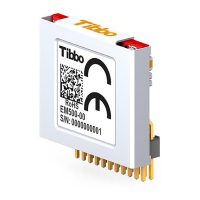271 Programmable Hardware Manual (PHM)
© Tibbo Technology Inc.
* (S5) on the diagram
** (S7) on the diagram
Tibbits with "Special Needs"
Most Tibbits happily work with simple control (GPIO) lines of the CPU. Some,
however, require dedicated I/O functionality from the CPU lines:
[SER] Tibbits that require TX and RX UART lines
[INT] Tibbits that require an interrupt line
[POE] Tibbits that require PoE power lines
[CAN] Tibbits that require CAN functionality
[AUD] Tibbits that require audio functionalily
[MMC] Tibbits that require MMC (SD) functionality
[USB] Tibbits that require USB functionality
7.2.5.1
[SER] Tibbits That Require UART Functionality
Some Tibbits, such as #01 (four-line RS232 port) and #02 (universal RS232/422/485
port) are designed to work with UART lines of the CPU. Of course, nothing "bad" will
happen if you just connect them to regular GPIO lines. After all, UART
communications at low baud rates can even be emulated with regular CPU pins. The
intended use of these Tibbits, however, is with TX and RX UART lines of the CPU.
TX and RX control lines, when present on a Tibbit, are always mapped onto the
control lines A and B, respectively:

